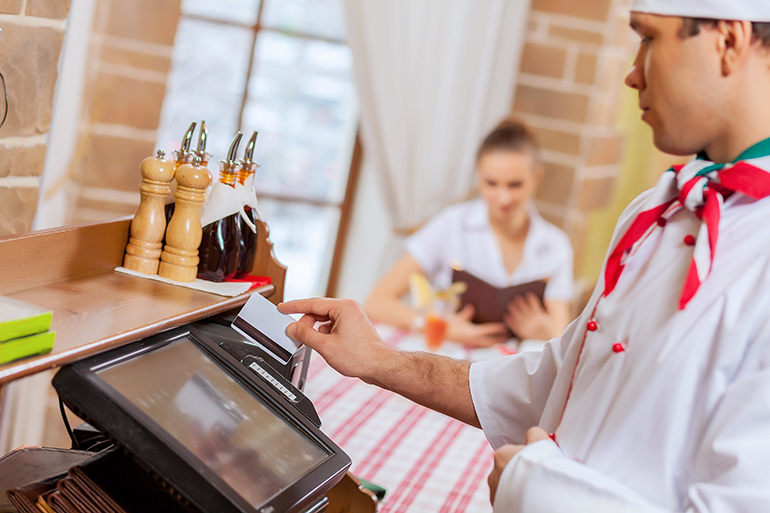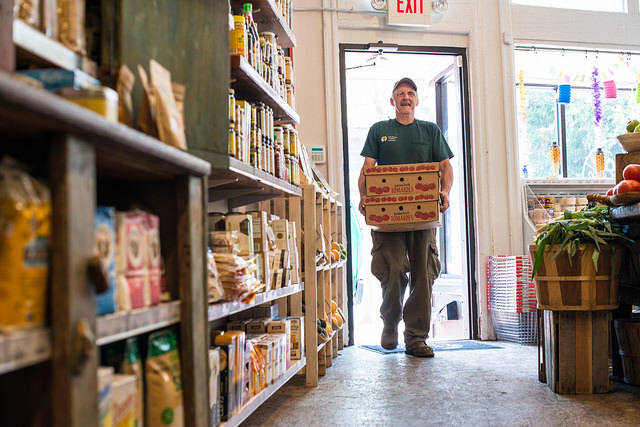 This is a brief API journey, where a restaurant owner needs to make an order for goods from one of their regular suppliers and replenish their inventory so that they can continue serving dinner for the rest of the week. Providing our catalyst for everyday business transactions that occurs millions of times around the world on any given day, while thoroughly demonstrating the importance of API infrastructure. This is intended to be a brief demonstration of what is possible when Axway API management and choreography solutions, along with Streamdata.io event-driven infrastructure is employed within the banking industry, to meet the needs of everyday business owners including real-time payments.
This is a brief API journey, where a restaurant owner needs to make an order for goods from one of their regular suppliers and replenish their inventory so that they can continue serving dinner for the rest of the week. Providing our catalyst for everyday business transactions that occurs millions of times around the world on any given day, while thoroughly demonstrating the importance of API infrastructure. This is intended to be a brief demonstration of what is possible when Axway API management and choreography solutions, along with Streamdata.io event-driven infrastructure is employed within the banking industry, to meet the needs of everyday business owners including real-time payments.
A Restaurant Owner Needs To Place An Order With A Supplier
A restaurant owner is need of some supplies to keep his business running through the week, choosing to use of his existing providers who he knows has the items he is looking for. Knowing that he will be able to make a real-time payment through his bank, which will expedite the delivery coming from his supplier, and bringing what he needs to stay in business.
1) The Restaurant Owner Visits Their Supplier Website – A restaurant owner is in need of some supplies to keep his business running through the week, choosing to use of his existing providers who he knows has the items he is looking for. Knowing that he will be able to make a real-time payment through his bank, which will expedite the delivery coming from his supplier, and bringing what he needs to stay in business.
2) The Restaurant Supplier Order Is Submitted Using API – A restaurant owner is in need of some supplies to keep his business running through the week, choosing to use of his existing providers who he knows has the items he is looking for. Knowing that he will be able to make a real-time payment through his bank, which will expedite the delivery coming from his supplier, and bringing what he needs to stay in business.
The Restaurant Supplier Receives Order
The restaurant supplier has received a notification that an order was made via their commerce system, letting them know there is a new order, allowing them to review the details of the order, and ensure that they can indeed fulfill the order at this moment. Triggering the initial event that will set real-time payment scenario into motion, showing what is possible with APIs using common every day scenarios that business users can relate to.
1) Payment Request Submitted To Restaurant Suppliers Bank API – The restaurant supplier has received a notification that an order was made via their commerce system, letting them know there is a new order, allowing them to review the details of the order, and ensure that they can indeed fulfill the order at this moment. Triggering the initial event that will set real-time payment scenario into motion, showing what is possible with APIs using common everyday scenarios that business users can relate to.
2) The Restaurant Supplier Payment Request Triggers An Event – The restaurant supplier has received a notification that an order was made via their commerce system, letting them know there is a new order, allowing them to review the details of the order, and ensure that they can indeed fulfill the order at this moment. Triggering the initial event that will set real-time payment scenario into motion, showing what is possible with APIs using common every day scenarios that business users can relate to.
3) Restaurant Supplier Requests Payment Using Their Bank Mobile App – The restaurant supplier has received a notification that an order was made via their commerce system, letting them know there is a new order, allowing them to review the details of the order, and ensure that they can indeed fulfill the order at this moment. Triggering the initial event that will set real-time payment scenario into motion, showing what is possible with APIs using common every day scenarios that business users can relate to.
4) Restaurant Supplier’s Bank Choreography Responds To Event – The restaurant supplier has received a notification that an order was made via their commerce system, letting them know there is a new order, allowing them to review the details of the order, and ensure that they can indeed fulfill the order at this moment. Triggering the initial event that will set real-time payment scenario into motion, showing what is possible with APIs using common every day scenarios that business users can relate to.
5) Restaurant Supplier’s Bank Choreography Validates Account – The restaurant supplier has received a notification that an order was made via their commerce system, letting them know there is a new order, allowing them to review the details of the order, and ensure that they can indeed fulfill the order at this moment. Triggering the initial event that will set real-time payment scenario into motion, showing what is possible with APIs using common every day scenarios that business users can relate to.
6) Restaurant Supplier’s Bank Choreography Coordinates With RTP Core – The restaurant supplier has received a notification that an order was made via their commerce system, letting them know there is a new order, allowing them to review the details of the order, and ensure that they can indeed fulfill the order at this moment. Triggering the initial event that will set real-time payment scenario into motion, showing what is possible with APIs using common every day scenarios that business users can relate to.
The Real Time Payment (RTP) Is Initiated
Leveraging their existing API infrastructure, through the streaming of events that occur across their API infrastructure, and their choreography engine, the restaurant supplier’s bank sends a payment request to Real Time Payment (RTP) core infrastructure for processing.
1) Real Time Payment (RTP) Sent To Core – A message is sent to the Real Time Payment (RTP) core, initiating payment request on behalf of restaurant suppliers bank (A). Moving the payment request beyond the supplier’s bank infrastructure, and negotiating the interaction with the restaurant owners bank.
Real Time Payment (RTP) Payment Request
Now that the restaurant suppliers bank has initiated a payment request with the Real Time Payment (RTP) core, it sends the payment request from the restaurant supplier’s bank to the restaurant owners bank for fulfillment. Initiating the other side of the payment request life-cycle, and engaging with the restaurant owners bank to actually get consent and satisfy the payment between the owner and supplier.
1) The Real Time Payment Request Triggers An Event – Now that the restaurant suppliers bank has initiated a payment request with the Real Time Payment (RTP) core, it sends the payment request from the restaurant supplier’s bank to the restaurant owners bank for fulfillment. Initiating the other side of the payment request life-cycle, and engaging with the restaurant owners bank to actually get consent and satisfy the payment between the owner and supplier.
2) Restaurant Owners Bank Choreography Engine Receives Event – Because the restaurant owner’s bank (B) uses a choreography engine they can monitor events that are being streamed across their existing API infrastructure, and trigger additional actions in response.
3) Restaurant Owners Bank Choreography Engine Validates Account – After receiving notification of the new payment request, the restaurant owner’s bank (B) can validate the restaurant owner’s account before continuing with sending out approval for payment.
4) Restaurant Owners Bank Choreography Engine Checks If Funds Are Available – After receiving notification of the new payment request, the restaurant owner’s bank (B) can validate that the restaurant has enough funds before continuing with sending out approval for payment.
5) Restaurant Owner Bank Notifies Restaurant Owner Of Payment Request – Upon receiving the payment request, and satisfying all other business logic required, the restaurant owner’s bank (B) can notify the restaurant owner of the payment request, allowing them to approve or deny the payment from their bank account.
Restaurant Owner Approves Payment to Supplier
Now that the restaurant owner’s bank has received and validated the payment request, as well as the fact that the restaurant owner has the funds to satisfy the request, and the bank has notified the restaurant owner, they will still need to personally approve the payment to be made from their account.
1) Restaurant Owner Visits Their Banks Mobile Application – The restaurant owner has received the notification of the suppliers\’ bank (A) payment request from their own bank (B) via their mobile application. Using their bank (B) mobile application they consent to the payment request, allowing it to be filled.
2) Payment Is Approved Using Restaurant Owner Bank API – Now that the restaurant owner’s bank has received and validated the payment request, as well as the fact that the restaurant owner has the funds to satisfy the request, and the bank has notified the restaurant owner, they will still need to personally approve the payment to be made from their account.
3) Restaurant Owner Payment Consent Triggers Event – Because the restaurant owner’s bank (B) is augmenting their existing web API with server-sent event technology, publishing a real-time stream for any new payment requests, they can provide streams for account payment request approvals which other systems can subscribe to.
4) Restaurant Owner’s Bank Choreography Engine Receives Event – Now that the restaurant owner’s bank has received and validated the payment request, as well as the fact that the restaurant owner has the funds to satisfy the request, and the bank has notified the restaurant owner, they will still need to personally approve the payment to be made from their account.
5) Choreography Engine Coordinates With RTP Core – The choreography engine that the restaurant owner\’s bank (A) uses handles the interaction with the Real Time Payment (RTP) core infrastructure. Sending the message needed to satisfy the restaurant owners consent to the payment request from the restaurant supplier.
Real Time Payment (RTP) Core Settles Payment
With the payment request satisfied and the Real Time Payment (RTP) core notified by the restaurant owners bank (B) regarding payment consent, RTP core can begin to settle the payment.
1) RTP Settles With Restaurant Suppliers Bank – The Real Time Payment (RTP) core settles with the restaurant suppliers bank (A), moving funds into the bank account of the supplier.
2) Bank Notifies The Restaurant Supplier – The bank (A) of the restaurant supplier notifies them that funds have been moved to their account, adjusting their balance, and the payment request has been satisfied.
3) RTP Settles With Restaurant Owners Banks – The Real Time Payment (RTP) core settles with the restaurant owners bank (B), removing funds from the bank account of the restaurant owner.
4) Bank Notifies The Restaurant Owner – The bank (B) of the restaurant owner notifies them that funds have been removed from their account, adjusting their balance and that the payment request has been satisfied.
Restaurant Supplier Schedules Delivery
With the real-time payment received, the restaurant supplier goes ahead and schedules the order for delivery to the restaurant. Enabling the restaurant owner to continue doing business, as well as the restaurant supplier to do what they do best, and giving the restaurant supplier the funds they need to purchase new items for their inventory.
Restaurant Owner Receives Their Order
The restaurant owner receives the order from their supplier, allowing them to continue with dinner service for the remainder of the week. Enabling them to be more flexible in their planning of the weekly service, being confident that they will be able to manage their finances in real-time, and purchase the supplies they need to keep their customers happy.


Follow us on social